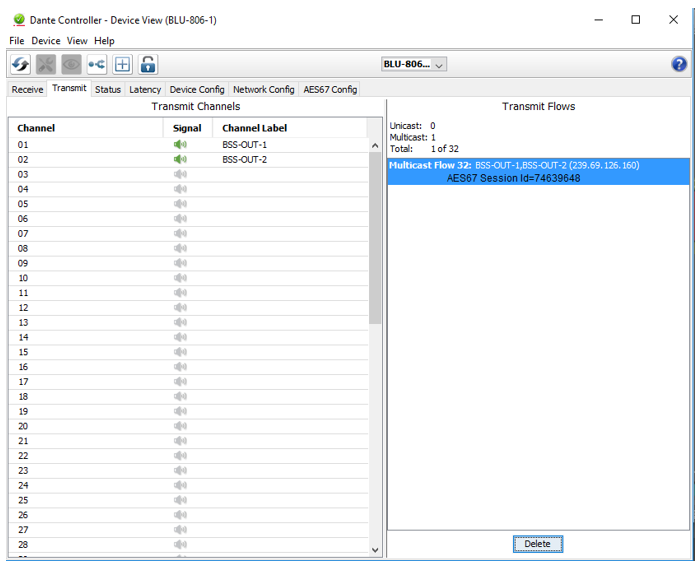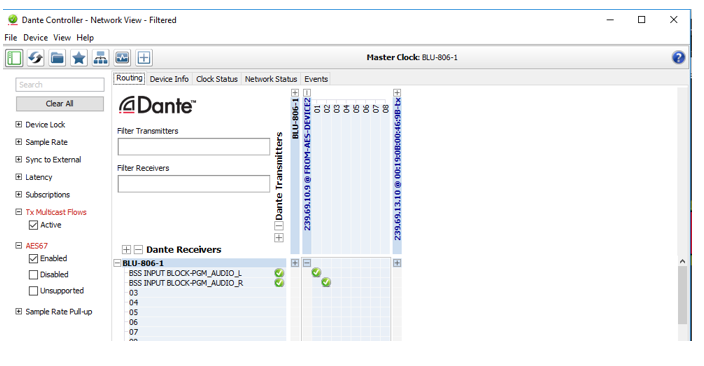Relevant Equipment
- BSS Blu-806DA (or other BSS model ending in "DA" )
- SVSI encoders & decoders (Not all models support AES67; models ending with an "A" typically support
- AES67, however check the specs to be certain or open up the web configuration and check if It has an
- AES67 tab at the top.)
- Audio Architect
- Dante Controller
Step 1: Download
- Audio Architect 2.0 or later
- Latest SVSI Firmware
- Dante Controller Application (https://www.audinate.com/products/software/dante-controller)
- Dante Firmware Updater (https://www.audinate.com/products/firmware-update-manager)
Step 2: Updates
- Update BSS Device Application firmware in Audio Architect Audio Architect
- Update the Brooklyn II Chips with Audinate Updater, and the file contained within AA download
- Typical File Path: “C:\Program Files\Harman Pro\Audio Architect (version #)\FirmwareUpdates\SoundWebLondonDante.dnt”
- Note, this may require physically connected the host PC to the primary Dante/AES port on the Soundweb device.
- Update SVSI Device(s) as needed to latest firmware that supports AES67
- Update Switch Configuration – the following configuration is for Cisco SG300 series switch, and can be utilized as well within the 500 series switch. Other switches may or may not require this configuration change. Check with HARMAN SVSI Technical Support for additional details.
The switch needs to be configured to statically route multicast groups:
224.0.0.230
- 224.0.0.231
- 224.0.0.232
- 224.0.0.233
To all ports within the network switch.
Example from VSW300-28 Below:
- ip igmp snooping vlan 999 static 224.0.0.230 interface gi1-28
- ip igmp snooping vlan 999 static 224.0.0.231 interface gi1-28
- ip igmp snooping vlan 999 static 224.0.0.232 interface gi1-28
- ip igmp snooping vlan 999 static 224.0.0.233 interface gi1-28
- Install Dante Controller and open the controller.
Step 3: Configuration of BSS
Once the firmware updates are completed, and the unit rebooted after the Boston II Chipset update, open audio architect and begin normal configuration of your program. Once the Soundweb devices have been added, in the device view click and highlight your Soundweb to show the device properties.
Select the ‘Dante’ Tab and verify that:
- AES67 Enabled = Yes
- AES67 Multicast Prefix = 69
The prefix can be changed, but the standard is 69. This is what generates the appropriate Multicast streams, and end up generating streams of 239.69.XX.YY from the unit. Changing 69, will result in a different multicast scheme and can disable connections to other sending and receiving devices.
Route Audio
Add a Dante Input Block, and click the grey ‘CH’ Button. In the following window, add channels the block by clicking the “add” button. 32 is the Maximum amount of channels. Renaming the channels in the block will populate to Dante Controller Later as “Block ID – Channel ID”
Add a Dante Output Block, and click the grey ‘CH’ Button. Repeat the same steps for the input block
above.
On both blocks, change “Routing Type” in the blocks properties to Dante Controller:

Send the file to the Sound Web device and go online with it.
In Dante Controller
Open Dante Controller, and click Device > Device View.
In Device View, Select the Sound Web Device, and then Click the Transmit Tab, then select from the top menu Device > Create Multicast Flow
In Multicast Flow:
Check the AES67 Flow
Then click to add the appropriate channels to the New Flow and then click Create
This will create the flow, and show the Multicast Address of the new flow.


The AES67 Stream will now be available to other AES Devices. This process creates a SAP/SDP message that other devices can be listening for. If the Dante Controller Application goes offline, the SAP messages will cease to be broadcast, but audio still routed WILL continue to function.
Return to the primary routing table of Dante Controller.
Click the top left icon to show the filter options, and verify that:
- Tx Multicast Flows = Active
- AES67 Enabled = Checked
In the routing table, the input/rx of the BSS Devices will appear in the table, but the SVSI devices will not. If the receiving device is available, click the cross point between the sources (top) and receivers (left) to route the audio.

In the SVSI Device (Encoder or Decoder)
Open the unit’s web page, and navigate to the AES67 Tab along the top.
Check the box to Enable AES67 – NOTE – this disables the PCM audio functionality of the unit and it will no longer send/receive from a standard Non-AES67 device, unless AES67 Mode is disabled. This functionality is controllable.
In the SVSi Encoder
Enter a multicast address for the desired outgoing stream. The address should have the same multicast prefix as the Sound web devices. You may wish to verify on the switch that any desired multicast address is not already in use by another device. Set the address to 239.69.XX.YY as needed. The Audio port is 5004.

In the SVSi Decoder
Enter in the Audio IP address found in the Dante Controller when setting up the multicast flow. The Audio Port is 5004. Select the number of channels being output of the Encoding source. NOTE – this is key, as the channel-count must match for proper audio output!
Click Save. The Unit should now be receiving the audio from the Sound Web Device.
